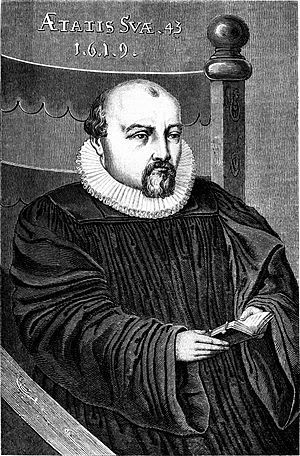Salomon de Caus facts for kids
Salomon de Caus (born 1576 in Dieppe, France – died 1626 in Paris) was a French Huguenot engineer. He was once mistakenly thought to have invented the steam engine.
Biography
Salomon de Caus was the older brother of Isaac de Caus. Because he was a Huguenot, which meant he was a Protestant in France, Salomon de Caus spent his life traveling across Europe.
He worked as an expert in water systems and as an architect for King Louis XIII. Caus also designed beautiful gardens in England, including one at Somerset House. He also created the famous Hortus Palatinus, or Garden of the Palatinate, in Heidelberg, Germany.
Caus came to England in late 1610 or early 1611. His first royal supporter was Anne of Denmark, who was the Queen, or her son, Prince Henry. They gave him money to support his work. Queen Anne even made him a special assistant in her royal household.
In November 1611, Caus gave advice to the Earl of Salisbury at Hatfield House. Records from 1611 or 1612 describe him as "Gardener to the Queen." He worked at Greenwich Palace and Denmark House. At Denmark House, he built a fountain with an artificial "rock." This "rock" looked like Mount Parnassus, a famous mountain in Greek stories. It had shells and a cave where nine Muses (goddesses of art and science) lived. On top was a statue of Pegasus, a winged horse, and nearby was a statue of the River Thames. At Greenwich, Caus might have designed a special cave that was used as a birdhouse. He also updated the gardens at Richmond Palace for Prince Henry. Later, he worked in Heidelberg for Elizabeth of Bohemia. King James gave him a gift of £50 in 1614.
Salomon de Caus also carried letters for important people. His name was sometimes spelled "Solomon Cole" in letters and court records.
In 1615, he published a book called Les Raisons des forces mouvantes. This book showed a pump that used steam, which was similar to one invented earlier by Giovanni Battista della Porta. Because of this, some people, like François Arago, mistakenly called him the inventor of the steam engine. In his book, Caus also described a musical scale called the just-intonation scale. He was also one of the first people to use the word work in the way it is used in modern physics, meaning the effort needed to move something.
Works
- Hortus Palatinus (1620) at the University of Heidelberg
- La Perspective avec la raison des ombres et miroirs (1611)
- Les Raisons des forces mouvantes (1615)
See also
 In Spanish: Salomon de Caus para niños
In Spanish: Salomon de Caus para niños


